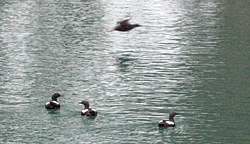Alaska Fish & Wildlife News
August 2008
Pigeon Guillemots

Learning to identify birds in Alaska can be intimidating, but it can also be very easy. The trick is to learn the most common birds, the same ones you see over and over. Pigeon guillemots are one of the most abundant diving seabirds in Southeast Alaska, and they are one of the most common seabirds in the west. Pigeon Guillemots are found from the Bering seacoast in Northern Alaska along the Pacific coastline to Southern California.
Pigeon guillemots are black birds with a distinct white wing bar. They have red feet, which are often visible when birds are in flight. As the picture shows, they also have red mouths. In winter, their plumage becomes more mottled, but the white wing bars are still distinct. They nest in loose colonies, often above rocky shores. A pair will lay two eggs, usually nesting in a small cavities and crevices in the rocks
These seabirds are alcids, diving birds that include murres, murrelets, auklets and puffins – these birds “fly” underwater, swimming with their wings. Guillemots are about a foot long, slightly larger than murrelets, and like murrelets, they tend to have difficulty taking off. To escape danger, they are more likely to dive and swim than to take off and fly.

Pigeon guillemots forage closer to shore than other Southeast alcids. There’s a good reason for that: Unlike their murrelet cousins, which generally forage in the water column and feed on schooling fish such as herring, guillemots tend to dive to the seafloor and then hunt for fish along the bottom. Blennies, a small, eel-like fish, are a favorite food, and they will also eat mollusks, crustaceans and marine worms.
One special adaptation for this sea floor foraging is the pigeon guillemots’ blood and hemoglobin. Their blood has the capacity to hold twice as much oxygen as the blood of the marbled murrelet, and guillemots are able to metabolize that oxygen almost twice as fast.
Subscribe to be notified about new issues
Receive a monthly notice about new issues and articles.
